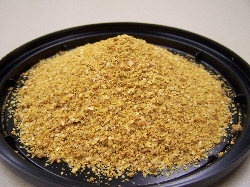



Feeding Value and Energy Prediction of DDGS with Variable Oil Content
University of Minnesota researchers, Fangzhou Wu, Pedro Urriola and Gerald Shurson, together with Lee Johnston and Adrienne Hilbrands of the West Central Research and Outreach Center in Morris outline their recent work evaluating the effects of feeding low-oil corn distillers dried grains with solubles (DDGS) to growing-finishing pigs.Corn DDGS is a major co-product of ethanol production, which has been widely used as an important energy and protein source in swine diets for several years.

About 35 million metric tons of DDGS are annually produced in the US and more than 12 per cent of this amount is used in the swine industry. However, in recent years, the majority of ethanol producers have been extracting corn oil before producing DDGS.
Consequently, traditional high-oil (more than 10 per cent oil) DDGS has been largely replaced by medium-oil (about seven to eight per cent oil) DDGS, while some ethanol plants are even producing a low-oil (less than five per cent oil) DDGS.
The swine nutrition group at the University of Minnesota has been devoted to studying the feeding applications and nutritional value of DDGS for swine for more than 15 years.
Results from their studies have shown that oil extraction in DDGS production has increased variability in energy and nutrient content, and consequently, the feeding value of DDGS. This has created a large gap or "disconnect" between price and value for DDGS in swine diets.
Traditionally, oil concentration is used as one of the two indicators (along with protein content) that determines DDGS price. However, the feeding value of DDGS is determined by its metabolisable energy (ME) and digestible amino acid content.
Results from University of Minnesota research have shown that oil content in DDGS is a poor predictor of ME content, which contributes to the 'disconnect' between DDGS price and value.
In addition, one of the biggest challenges of using traditional high oil (over 10 per cent) DDGS in growing-finishing pigs diets is that the corn oil is high in polyunsaturated fatty acids, which causes pork fat (especially bellies used to produce bacon) to become softer and more "oily". This can lead to challenges in further processing of pork products, a less attractive appearance, and potentially reduced shelf life. Therefore, reducing the oil content in DDGS may improve pork fat quality but no studies have been conducted to determine the extent of improvement.
Because of the poor relationship between oil content of DDGS and ME content, the authors developed prediction equations to estimate ME content of DDGS from it chemical composition. Our research has shown that the most accurate and precise published ME prediction equations are:
- Digestible energy = -2,161 + (1.39 × gross energy) - (20.7 × neutral detergent fibre) - (49.3 × ether extract)
- ME = -261 + (1.05 × digestible energy) - (7.89 × crude protein) + (2.47 × neutral detergent fibre) - (4.99 × ether extract)
However, before nutritionists can have confidence in using these equations, their accuracy must be tested under practical commercial production conditions.
To do this, the researchers conducted an experiment at the University of Minnesota's West Central Research and Outreach Center to determine the impact of feeding DDGS with variable oil content on growth performance, carcass characteristics and pork fat quality of growing-finishing pigs.
The DDGS sources used in this study contained six, 10, or 14 per cent oil but similar predicted ME content, based on the prediction equations. Each DDGS source was added to growing-finishing pig diets to represent 40 per cent of the total diet, and these diets were fed to pigs starting at about 85 lbs. bodyweight until they were harvested at about 260 lbs.
Pigs fed these diets containing different DDGS sources had the same growth rate, average daily feed intake and final bodyweight. However, pigs fed the six per cent oil DDGS diets had slightly reduced gain efficiency, suggesting that the ME prediction equations do a good job of estimating ME content of DDGS source containing more than six per cent oil but slightly overestimate ME content of DDGS sources containing less than six per cent oil.
These pigs also had similar hot carcass weight, dressing percentage, backfat depth, loin muscle area and percentage of carcass lean, indicating no differences in carcass characteristics when these different DDGS sources of variable oil content were fed.
The authors also evaluated pork fat quality from carcasses of pigs fed the DDGS diets containing different oil content.
Feeding the six per cent and 10 per cent oil DDGS diets improved pork fat firmness, including the belly fat, compared with carcasses from pigs fed 14 per cent oil DDGS. These results suggest that oil extraction in DDGS decreases the negative impact of feeding DDGS on pork fat quality.
Wu and colleagues concluded that the oil content of DDGS does not affect the growth performance and carcass traits of growing-finishing pigs as long as the sources have similar ME content, but reducing the oil content of DDGS improves pork fat quality.
They added that the best ME prediction equations developed so far work well when applied to DDGS sources that contain more than six per cent oil, but overestimate ME content of DDGS sources containing less than six per cent oil.
October 2014








